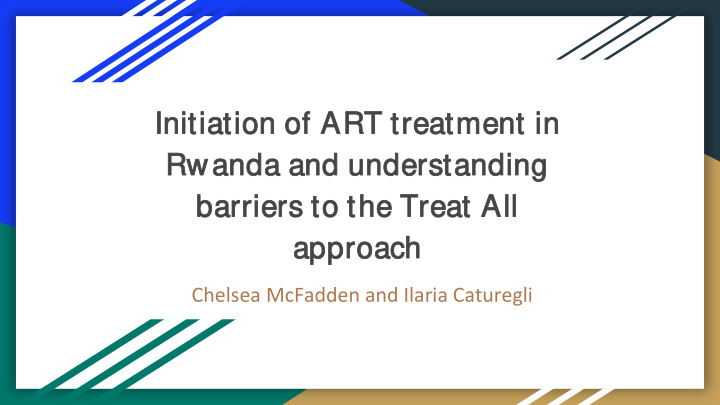



Initi tiati tion o of A ART tr treatm tment t in Rwan anda an a and u underst stan anding barri rriers rs to t the T Tre reat A All ap approac ach Chelsea McFadden and Ilaria Caturegli
Incidence and Prevalence of HIV/AIDS in Rwanda ● 214,904 Rwandans are HIV+ ● Incidence: About 3/1000 persons per annum ● For every 10% increase in antiretroviral therapy (ART) coverage, there is a 6% reduction in incidence
Background: Treat All Protocol What is the Treat All Protocol? ● The implementation of the WHO’s evidence-based recommendation to remove conditions for initiation of antiretroviral therapy in patients infected with HIV/AIDS, and instead treat all patients affected with the disease In Rwanda: ● HIV infected: Initiation on first-line ART therapy ● Patients see HCPs every three months for HIV/AIDS care consultation and medication refills ● DSDM: Consistent viral load suppression, allows for patients to come every six months
Our Project: ART Initiation and Understanding Barriers to the Treat All Approach ● Three Days of Clinic Visits ○ Day 1: Kagugu ○ Day 2: Avega ○ Day 3: Remera ● One Day in Hospital ○ Day 4: Kibagabaga Hospital
Our Project: Typical Clinic Visit ● Setting: ○ Generally conducted a small to medium sized room inside of the clinic ○ There is a table that separates the patient from the healthcare provider ■ Examination table may be present, but patients do not use it ○ Patients waited on benches or chairs outside of the room, and were called in by the next patient ● Providers: Doctors or Nurses ○ HCPs interview the patient about their condition ■ Review their CD4 count and viral load ■ Ask about compliance ■ Problems with the medications ■ Other symptoms/medical concerns ■ Write a refill for their next supply of medication or suggest a change in therapy ○ They complete each patient’s dossier (paper health record) with what happened during the patient encounter
Understanding Barriers to Care ● Familial Problems ● Religious Beliefs ● Type of Employment ● Financial and Resource Limitations ● Training of Healthcare Providers The overarching cause of virologic failure is poor adherence
2017 H 2017 HIV Scientific W W orkshop Glo lobal H l HIV a and V Vir iral l Hepatit itis is scie ientif ific ic u updates t to in inform compreh ehen ensive H e HIV g guidel elines es f for Rw Rwanda
HIV Scientific W orkshop ● HIV Prevention ● HIV Care & Treatment ● Sexually Transmitted Infections (STIs) and Other Blood Borne Infections (OBBIs) https://pbs.twimg.com/profile_images/3063848123/f49ddde4e9 5c6c06c7b892b9489c07b4_400x400.jpeg
HIV Prevention ● Testing: self, targeted, linkage to care ● Tetanus vaccine in context of voluntary medical male circumcision (VMMC) ● Prevention of mother-to-child transmission (PMTCT) ● Vaccine http://www.who.int/hiv/pub/mtct/mtct_training.gif
HIV Prevention: Testing ● Targeted testing ● Self testing ● Linkage to care In R n Rwand nda, 3.8 m millio illion n peopl pe ple in 2016 2016 alone wer ere t e tes ested ed for HIV and nd kno now the heir ir status. https://i.pinimg.com/736x/20/39/43/203943df47d7c0369adf9e3abced2103--treatment-for-hiv-hiv-images.jpg
HIV Care & Treatment ● Community actors in achieving 90/90/90 ● Novel ART Therapies ● Adherence, Monitoring with Differentiated Service Delivery Model (DSDM) ● Comorbidities & opportunistic infections (OI) prophylaxis ● Children & adolescents http://consumentenkring.com/wp-content/uploads/2016/03/aids- 1170x781.jpg
HIV Care & Treatment: Community Actors & 90/90/90 1 82 AVERT & UNAIDS & Nsanzimana
HIV Care & Treatment: Community Actors & 90/90/90
HIV Care & Treatment: Community Actors & 90/90/90 https://thumbnails-visually.netdna-ssl.com/we-can-end-hivaids-today-with-treatment_50291c42aef05_w450_h600.jpg
HIV Care & Treatment: Adherence, Monitoring, DSDM ● Retention ● Continuum of care ● Key populations ● Feasibility ● Task shifting ● Cost effectiveness ● Integration WHO
HIV Care & Treatment: Children & Adolescents In f n follo llow-up = = 1, 1,449/ 449/3, 3,244 = 244 = 44. 44.67% 67% Tene G, Lahuerta M, Teasdale C, et al. High Retention Among HIV-infected Children in Rwanda During Scale-up and Decentralization of HIV Care and Treatment Programs, 2004 to 2010. The Pediatric infectious disease journal . 2013;32(8):e341-e347. doi:10.1097/INF.0b013e31828c2744.
Reflections and Conclusions ● We were humbled to deepen our learning about the genocidal history of Rwanda, yet awed at how far the country has come in rebuilding and revitalizing itself. ● There is much to be learned from the country’s commitment to “Never go back”
Thank you! Questions?
Acknowledgements Dr. David Riedel, our mentor All healthcare providers we worked with in Rwanda
References Consolidated Guidelines on the Use of Antiretroviral Drugs for Treating and Preventing HIV Infection . 2016, apps.who.int/iris/bitstream/10665/208825/1/9789241549684_eng.pdf?ua=1. “National Guidelines for Comprehensive Care of People Living with HIV in Rwanda .” aidsfree.usaid.gov/sites/default/files/tx_rwanda_2011.pdf. Ndahimana, J d, et al. HIV Drug Resistance Mutations among Patients Failing Second-Line Antiretroviral Therapy in Rwanda. U.S. National Library of Medicine, 12 Nov. 2015, www.ncbi.nlm.nih.gov/pubmed/26562173. Nsanzimana, Sabin. “‘Treat All’ HIV+ In Rwanda .” Geneva IAPAC Meeting . Geneva IAPAC Meeting , Oct. 2013. Other references also included on individual slides
Recommend
More recommend